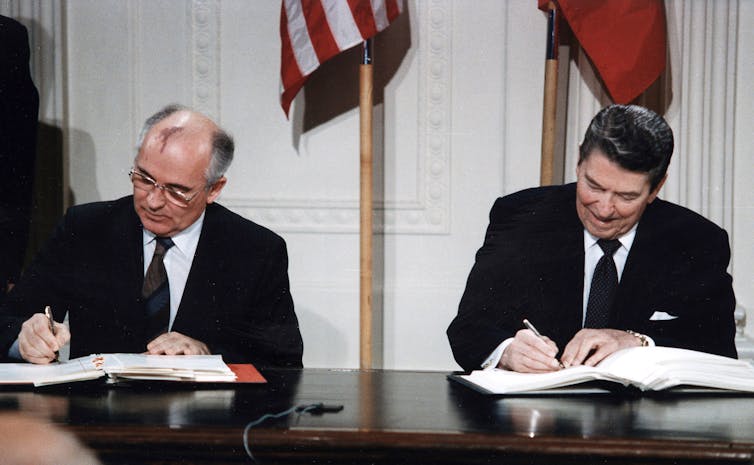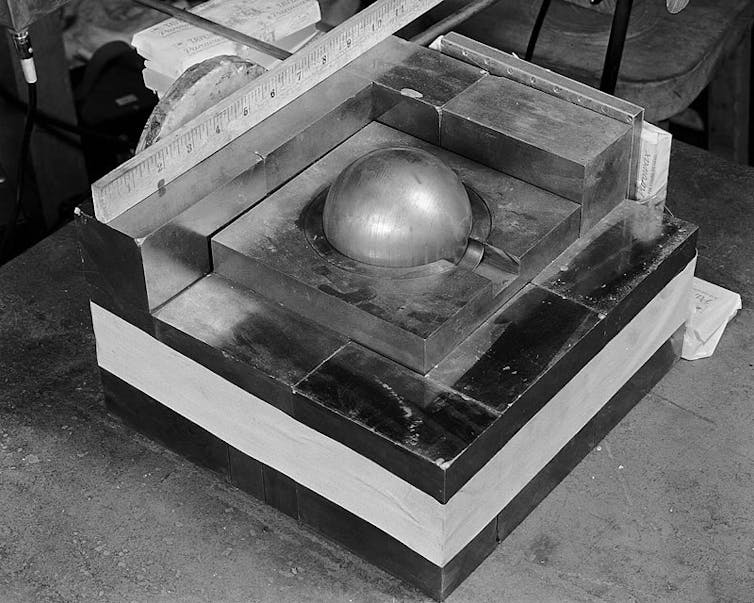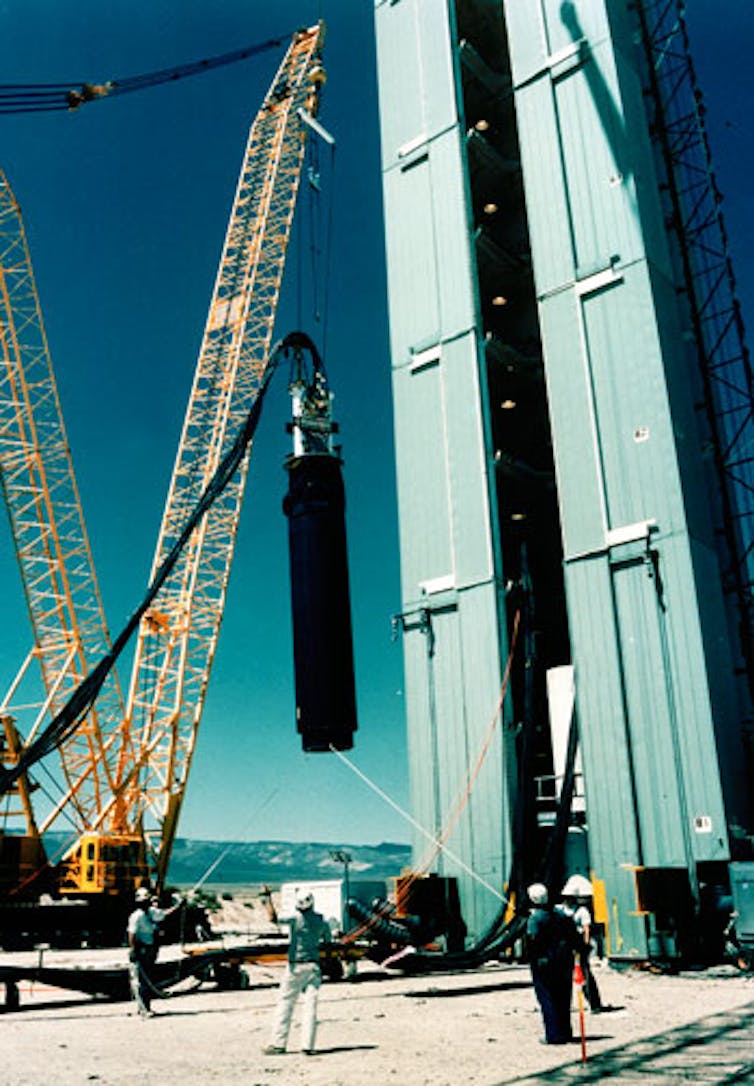A restart of nuclear testing offers little scientific value to the US and would benefit other countries
by & - The Conversation
July 14, 2020
July 15, 2020 marks 75 years since the detonation of the first nuclear bomb. The Trinity Test, in New Mexico’s Jornada del Muerto desert, proved that the design for the Nagasaki Bomb worked and started the nuclear era.
Hundreds of nuclear weapons have been tested by the U.S. since WWII,
but
newer science has replaced the need for live detonations.
Although the Senate never ratified the treaty and it never entered into force, all 184 countries that signed the test ban, including the U.S., have followed its rules. But in recent weeks, the Trump administration and Congress have begun debating whether to restart active testing of nuclear weapons on U.S. soil.The U.S. tested nuclear bombs for decades. But at the end of the Cold War in 1992, the U.S. government imposed a moratorium on U.S. testing. This was strengthened by the Clinton administration’s decision to sign the Comprehensive Nuclear Test Ban Treaty.
Some conservative Republicans have long expressed concerns over the reliability of aging U.S. warheads and believe that testing is a way to address this problem. Additionally, the U.S., Russia and China are producing novel types of nuclear missiles or other delivery systems and replacing existing nuclear weapons – some of which date to the Cold War – with updated ones. Some politicians in the U.S. are concerned about the reliability of these untested modern weapons as well.
We are two nuclear weapons researchers – a physicist and an arms control expert – and we believe that there is no value, from either the scientific nor diplomatic perspective, to be gained from resuming testing. In fact, all the evidence suggests that such a move would threaten U.S. national security.
As the Cold War came to an end, the U.S. and the Soviet Union both began
reducing their numbers of nuclear weapons, setting the stage for the testing ban.
Why did the US stop testing?
Since the Trinity Test in July 1945, the U.S. has detonated 215 warheads above ground and 815 underground. These were done to test new weapon designs and also to ensure the reliability of older ones.
When the Cold War ended, the U.S. pledged to stop doing such tests and a group within the United Nations began putting together the CTBT. The goal of the test ban treaty was to hinder new nations from developing nuclear arsenals and limit the capabilities of nations that already had them.
Subcritical testing to maintain the arsenal
After the U.S moratorium went into effect, the U.S. Department of Energy created a massive program called the Stockpile Stewardship Program to maintain the safety and reliability of U.S. nuclear weapons. Instead of crudely blowing up weapons to produce a nuclear explosion, scientists at facilities like U1A in Nevada began conducting what are called subcritical tests.
[Expertise in your inbox. Sign up for The Conversation’s newsletter and get expert takes on today’s news, every day.]
In these tests, the plutonium that drives the nuclear chain reactions is replaced by a similar-acting but non-nuclear explosive material such as tungsten or a modified plutonium shell. There is still a big bang, but no nuclear chain reaction.
Rather, these experiments produce data that researchers feed into elaborate supercomputer programs built using the massive amounts of information collected from earlier live tests. Using these subcritical tests and earlier data, scientists can simulate full-scale detonations with incredible accuracy and monitor the current arsenal without blowing up nuclear warheads.
Plutonium pits are one of the only pieces of a nuclear warhead
that can’t be replaced. Los Alamos National Security LLC, CC BY-ND
What could be going wrong in the bombs?
All nuclear weapons currently in the U.S. stockpile are two-stage nuclear weapons called hydrogen bombs. Put simply, hydrogen bombs work by using a smaller nuclear bomb – akin to the bomb dropped on Nagasaki – to detonate a second, much more powerful bomb.
Nearly all the components of a nuclear weapon can be replaced and updated except for one piece – the explosive plutonium core known as the pit. These pits are what trigger the second, larger explosion.
The weapons in the U.S. arsenal are, on average, about 25 years old. The main concern of people pushing to resume testing is that the plutonium pits may have deteriorated from their own radiation in the time since they were made and will not properly trigger the second fusion stage of the explosion.
Since most of the previous tests were done on much younger bombs with newer plutonium pits, supporters of testing claim that the subcritical tests cannot accurately test this part of the process.
The deterioration of the plutonium pit is a valid concern. To study this, researchers at Lawrence Livermore National Laboratory used a far more radioactive type of plutonium and artificially aged the metal to simulate the effects of what would be equivalent to 150 years of radiation on a normal plutonium pit. They found that the aged plutonium pits “will retain their size, shape, and strength despite increasing damage from self-irradiation,” and concluded that “the pits will function as designed up to 150 years after they have been manufactured.”
This isn’t to say that scientists can stop worrying about the aging of U.S. nuclear weapons. It’s important to continue “to assess and, if necessary mitigate threats to primary performance caused by plutonium aging”, as the JASON group – a group of elite scientists that advises the U.S. government – says.
However, these scientists do not suggest that it is necessary to conduct live nuclear tests. Decades of experimental studies by nuclear weapons laboratories have led experts to believe that the U.S. can maintain the nuclear arsenal without testing. And in fact, as the former director of Los Alamos National Labs, Dr. Sigfried Hecker said recently, many believe that by resuming testing, “we would lose more than we gain.”
The last nuclear test ever conducted by the U.S. was done on Sept. 23, 1992,
at an underground test facility in Colorado, and was described as a
‘test to ensure safety of deterrent forces.’ Los Alamos National Laboratories
Little to gain, much to lose
Nuclear weapons are intricately tied to the world of geopolitics. So if there isn’t a scientific need to resume testing, is there some political or economic reason?
The U.S. has already spent tens of billions of dollars on the infrastructure needed to conduct subcritical tests. Additionally, a new, billion-dollar facility is currently being built in Nevada that will provide even finer detail to the data from subcritical test explosions. Once subcritical test facilities are up and running, it is relatively inexpensive to run experiments. Nuclear testing won’t save the U.S. money.
So is it politics?
Currently, nuclear powers around the world are all improving the missiles that carry nuclear warheads, but not yet the warheads themselves.
With little evidence, the Trump administration has sought to sow suspicion that Russia and China may be secretly conducting very low-yield nuclear tests, implying that the countries are trying to build better nuclear warheads. In response, movement towards testing in the U.S. has already begun.
The Senate Armed Services Committee recently approved an amendment to spend US$10 million to cut the time it would take to conduct a test if the president ordered one. Some officials seem to believe that a resumption of U.S. testing – or the threat of it – could give Washington an upper hand in future arms control negotiations.
But we believe the opposite to be true. Even though the Comprehensive Test Ban Treaty has not entered into force, nearly every nuclear power on earth has more or less followed its rules. But if the U.S. were to resume nuclear testing, it would be a green light for all other nations to start their own testing.
The U.S. already has the ability to perform subcritical tests and data from over 1,000 test detonations that scientists can use to modernize, improve and maintain the current arsenal. No other country, aside from Russia, has as robust a foundation. If the ban were broken, it would give other countries like Iran, India, Pakistan and China a chance to gather huge amounts of information and improve their weapons while the U.S. would gain next to nothing.
When it comes to the U.S nuclear testing ban, our view is, if it ain’t broke don’t fix it.




No comments:
Post a Comment